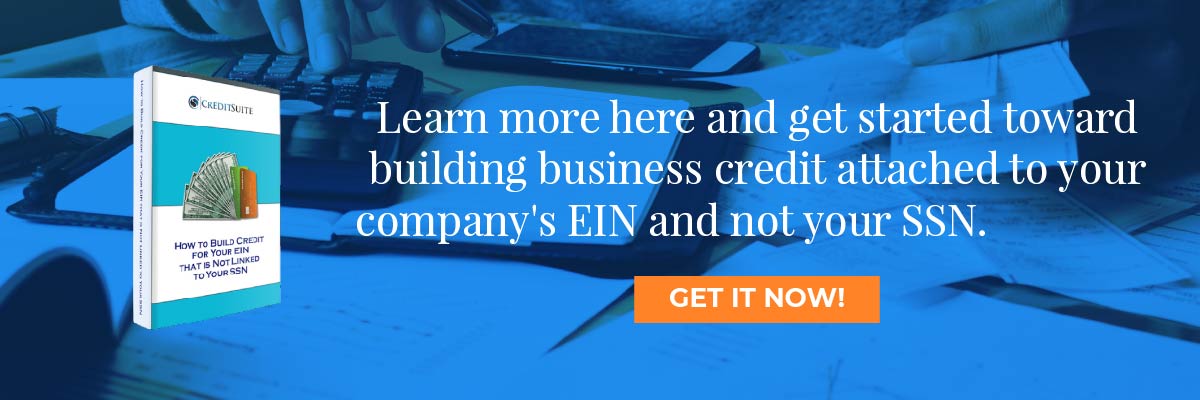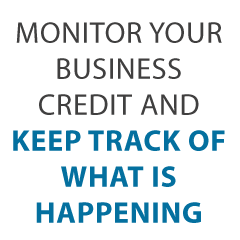- Connect With Us!
- (877) 600-2487
- info@creditsuite.com
5 Fantastically Easy Ways to Manage Your Business Credit Profile
Published By Janet Gershen-Siegel at August 5th, 2017
Manage Your Business Credit Profile – the Key to Getting and Keeping Higher Scores
Are you looking for how to manage your business credit profile? We’ve got five great ways to do so, and you can get started today. This will make it easier for you to get loans and credit, and you will get better terms for both.
It can also mean the difference between wanting company credit and loans, and not getting them at all. So let’s get started.
1. Manage Your Business Credit Profile: Do Your Best to Improve Your Payment History
How do you make your company’s payment history better? It’s simple – pay your bills on time, and as close to ‘in full’ as you can. That can be easier said than done. You must keep personal spending within your means. In the same way, you also must keep your small business spending realistic.
Your payment patterns and history are a driving force in your overall credit score. Over time, paying your invoices on time will help establish your business as one that pays their financial obligations. This will certainly help push your score up and show other business you are a low risk.
2. Manage Your Business Credit Profile: Credit History Length Matters
This is how long your company has been using business credit. Naturally newer businesses have short credit histories. While there is not a lot you can specifically do about that, do not despair.
Credit reporting bureaus will also review your consumer credit score and your own history of payments. If your FICO is good, particularly over a long credit history, then your consumer credit can come to the rescue of your business.
That is, you did not just get your first credit card recently.
Naturally the opposite is also true. So if your personal credit history is poor, it will impact your company credit scores until your business and consumer credit can split.
3. Manage Your Business Credit Profile: Stay on Top of Your Scores
No matter what your credit score is, keep on top of and review your personal and business credit reports. This can help you locate real concerns and understand your credit profile.
Monitor Your Business Credit
Know what is happening with your credit. Make sure it is being reported and attend to any errors ASAP. Get in the habit of checking credit reports and digging into the details, and not just the scores.
We can help you monitor business credit at Experian and D&B for 90% less than it would cost you at the CRAs. See: fastcs.wpengine.com/monitoring.
At Equifax, you can monitor your account at: www.equifax.com/business/business-credit-monitor-small-business. Equifax costs about $19.99.
Update Your Data
Update the information if there are inaccuracies or the details is incomplete. At D&B, you can do this at: https://iupdate.dnb.com/iUpdate/viewiUpdateHome.htm. For Experian, go here: www.experian.com/small-business/business-credit-information.jsp. So for Equifax, go here: www.equifax.com/business/small-business.
4. Manage Your Business Credit Profile: Fix Your Business Credit
So, what’s all this monitoring for? It’s to dispute any problems in your records. You can correct errors in your credit reports. But the CRAs want you to dispute in a particular way.
Get your company’s PAYDEX report at: www.dnb.com/about-us/our-data.html. Get your company’s Experian report at: www.businesscreditfacts.com/pdp.aspx?pg=SearchForm. And get your Equifax business credit report at: www.equifax.com/business/credit-information.
Disputes
Disputing credit report errors often means you mail a paper letter with duplicates of any proofs of payment. These are documents like receipts and cancelled checks. Never mail the original copies. Always send copies and keep the original copies.
Fixing credit report mistakes also means you precisely itemize any charges you contest. Make your dispute letter as crystal clear as possible. Be specific about the issues with your report. Use certified mail for proof that you mailed in your dispute.
Dispute your or your business’s Equifax report here: www.equifax.com/small-business-faqs/#Dispute-FAQs.
Dispute inaccuracies on Experian reports here: www.experian.com/small-business/business-credit-information.jsp.
And D&B’s PAYDEX Customer Service contact number is here: www.dandb.com/glossary/paydex.
5. Manage Your Business Credit Profile: Keep Your Debt-to-Income Ratio in Check
The more debt you have on your plate, the more invoices you have, as well as the less disposable income you have. If total debt approaches or surpasses income level, you’re probably seen as high-risk.
Keep your debts in check and consistently pay them off. Keep a healthy balance between what you make and what you owe.
Learn more here and get started toward building business credit attached to your company’s EIN and not your SSN.
Bonus 6. Manage Your Business Credit Profile: Use Your Credit
Keeping your debts low continues to be a sound recommendation. Still, opening and sensibly using business credit accounts can help you broaden your available credit. This can improve your credit score. This also helps with utilization. Utilization ratio is less of an issue for business than it is for personal credit. But it’s still relevant and it still helps you to keep your spending in check.
Bonus 7. Manage Your Business Credit Profile: Maintain a Healthy Personal Credit Profile
Personal credit is fair game when it comes to your Intelliscore Plus score. Running a company is difficult work. But don’t let your individual finances suffer. Keep on top of your personal monthly bills. Stay clear of unnecessary credit inquiries. And don’t use your personal credit for company needs.
Bonus 8. Manage Your Business Credit Profile: Learn About What is in Your Business Credit Reports
Dun & Bradstreet’s PAYDEX Business Credit Score
A PAYDEX Score from Dun & Bradstreet ranges from 0 to 100. This score has a basis in payment information which is on report to the agency. Or it is on report to data-gathering companies partnering with the CRA. https://creditreports.dnb.com/m/business-glossary/paydex-score.html
D & B uses this information, with a credit score and financial stress score. So this is to recommend the amount of credit a lender ought to extend to your small business.
Dun & Bradstreet takes many factors into account in developing such a report. These include a predictor of payment delinquency. This is how financially stressed a company is versus similar businesses. Plus an assessment of supplier risk. And there’s a credit limit recommendation; D&B rating; and PAYDEX score.
Getting a PAYDEX Score
To get a PAYDEX number, you must file for a D-U-N-S number by using Dun & Bradstreet’s site. The number is free. Plus the credit reporting agency has to have reports of your payments with four or more vendors.
Your small business’s PAYDEX score shows if your payments are usually made on time or early. As you may expect, a higher number is better.
PAYDEX Score Details
A PAYDEX Score is Dun & Bradstreet’s proprietary dollar-weighted numerical indicator. It shows how a firm has settled its bills over the past year. The score is based upon trade experiences reported to Dun & Bradstreet by a variety of vendors.
The scores break down as follows:
- 80 – 100: A low risk of late payments
- 50 – 79: A medium risk of late payments
- 0 – 49: A high risk of late payments
An outstanding PAYDEX score for your company is 80 – 100.
Experian Credit Scores
Experian retains business credit profiles on 99.9% of all United States businesses. It boasts the credit industry’s most wide-ranging information on small and midsize companies. The truth is; your firm is most likely currently listed on Experian.
Per Experian, all their data originates from third party sourcing. so, you cannot add any information to your business credit profile. But you can still examine your profile and of course tell Experian about any problems.
Business Owner Profile
Experian adds a business owner profile to show connections between you, the owner, and your business. Experian’s Business Owner Link instantly links the credit history of business owners to the business credit history. There are more than 5 million of them. This makes it much easier for creditors to see a Business Owner Profile on small business accounts. It also keeps it easier for creditors to determine your total creditworthiness.
Experian’s scoring system is Intelliscore Plus. http://www.experian.com/business-information/credit-risk-management.html
Experian’s Credit Score report includes a business credit score with other details, like account histories, payment trends, and public records. Experian commercial credit scores run from 1 to 100.
Unlike Dun & Bradstreet’s PAYDEX score and Equifax’s payment index, Experian takes into account several factors, beyond payment histories.
What is the Intelliscore Plus Credit Score?
This score is a statistically based credit-risk examination. The goal is to help companies, investors, and possible future loan providers make smart judgments about who to do business with.
Like a car dealer uses a FICO score to quickly see how much of a credit risk a potential customer might be, the Intelliscore Plus credit score offers insights in business or owner credit risk levels.
An epic Experian score for your business is 76-100.
Learn more here and get started toward building business credit attached to your company’s EIN and not your SSN.
Equifax Business Credit Scores
The Equifax Credit Risk Score originates from a model which they use to rank specific risks. Equifax uses these details in its calculations. They include the depth of the credit information Experian can get. It also includes the length of your business’s credit history. And it has your firm’s payment delinquency history. http://www.equifax.com/business/equifax-risk-score
http://www.equifax.com/assets/USCIS/efx-00178_efx_risk_score.pdf
http://www.equifax.com/assets/USCIS/efx-00164-9-13_efx_bni.pdf
Equifax then segments some five different scorecards with each other, with statistical analysis. For more precision, Equifax recommends integrating their Credit Risk Score with their exclusive Equifax Bankruptcy Navigator Index.
The Bankruptcy Navigator Index helps forecast the possibility of your company going bankrupt in the next 24 months. Equifax bases its predictive model on over 270 million separate accounts.
Equifax shows three separate business determinations on its commercial credit reports. These are the Equifax payment index, your company’s credit risk score, and its business failure score.
Equifax Payment Index
Like a PAYDEX rating, this score is on a range of 100. It shows how many of your company’s payments were made on time. These consist of both information from credit issuers as well as suppliers.
Yet it’s not suggested to predict future actions. That is what the other two ratings are for.
Equifax Credit Risk Score
This score shows how likely it is your business will get severely overdue on payments. Scores range from 101 to 992. They review:
- Available credit limit on revolving credit accounts, e. g. credit cards
- Your company’s size
- Proof of any type of non-financial transactions (e. g. vendor billings) which are overdue or were on charge off for two or more payment cycles
- Length of time since the opening of the oldest financial account
Equifax Business Failure Score
This score looks at the risk of your small business closing. It varies from 1,000 to 1,600, examining these elements:
- Total balance to total current credit limit average utilization in the previous three months
- Time since the opening of the oldest financial account
- Your business’s worst payment status on all trades in the previous 24 months
- Documentation of any type of non-financial transactions (e. g. vendor billings) which are past due or have been on fee off for two or more billing cycles.
Equifax Scoring Analysis
For the credit risk as well as business failure scores, a rating of 0 means bankruptcy.
An outstanding Equifax score for your firm is as follows:
- Payment Index 0 – 10
- Credit Score 892 – 992
- Business Failure Score 1400 – 1600
Learn more here and get started toward building business credit attached to your company’s EIN and not your SSN.
FICO Business Credit Scores
FICO has a SBSS (Small Business Scoring Service) Score. It uses it to incorporate consumer bureau, financial, application, and business bureau data. FICO then checks their SBSS models for deals like Line of Credit transactions, Term Loans, and Industrial Card obligations. These go up to $1 million. Their idea is to review exactly how your business pays back all sorts of loans. http://www.fico.com/en/node/8140?file=6045
Business credit providers use this score to decide if they should lend to your company at all.
The SBA uses this score as well, to allow or approve business loans. It comes from company and consumer credit history, not just business’s financial health.
The score factors in the risks inherent in your company’s credit applications. With SBSS, lending institutions make their decisions in a matter of hours, as opposed to days. Lenders are more confident in their lending judgments. And your business gets faster decisions on your loan applications.
Computing a FICO SBSS Score
The FICO SBSS Score shows if you, the candidate, can cover month-to-month costs on schedule. The score ranges from 0 to 300. A higher score means reduced risks and often generates more positive credit terms. The score comes from your company and individual history of credit use. It also comes from your business’s financial information. Variables also include your business’s age, and its years or complete time in business.
Since 2014, all SBA 7(a) loans must go through a business credit score pre-screen. And for SBA loans, you could possibly not get an approval if you had a score less than 140. Yet the cutoff was Often set to 160, and most of the times, a score under 160 meant a rejection. Many lenders will just accept scores above 160 or 180, to lend up to $1 million. Yet a score lower than 160 or 180 can still qualify you for a smaller sized loan.
The formula for the FICO SBSS Score is:
- The last year of PAYDEX scores from Dun & Bradstreet
- Amounts and types of any judgements against your firm
- The amounts and kinds of any liens against your firm’s real or personal property.
- Your business’s available resources
- Your small business’s profit
- And other, less distinct monetary information
If you have no business credit record with a short time in business, the highest FICO SBSS score you might get is 140.
The Kind of Information in the Score
The SBSS offers credit issuers various information blends to check business credit risks. Hence if the lender selects the PAYDEX score, the SBSS pulls that set of information.
The Updated SBSS
Reporting agencies like Experian power the newer FICO SBSS Score model. They may use SBFE information to prepare for charge-offs or bankruptcy. Or they will check three plus cycles of overdue or misbehavior over a period of two years.
SBA Credit Scoring
The SBA’s tool has a basis in FICO. Their idea is to quicken their credit decisions for loan approvals. The tool uses several data sources. There are also over one hundred combinations of company and consumer analytical models. They use a designated cutoff.
https://www.sba.gov/offices/district/mo/st-louis/resources/small-business-loan-credit-scoring
General statistics on their over $60 billion portfolio prove it. Businesses with scores at or above the assigned cut-off have excellent payment history.
Manage Your Business Credit Profile: Takeaways
Once you can manage your business credit profile, you can build better business credit. Business credit is an asset which can help your company for many years to come.

 " class="attachment-blog-single size-blog-single wp-post-image" alt="Get Business Credit Cards for New Businesses Credit Suite-Business Line of Credit Decoded" title="Get Business Credit Cards for New Businesses">>
" class="attachment-blog-single size-blog-single wp-post-image" alt="Get Business Credit Cards for New Businesses Credit Suite-Business Line of Credit Decoded" title="Get Business Credit Cards for New Businesses">>
